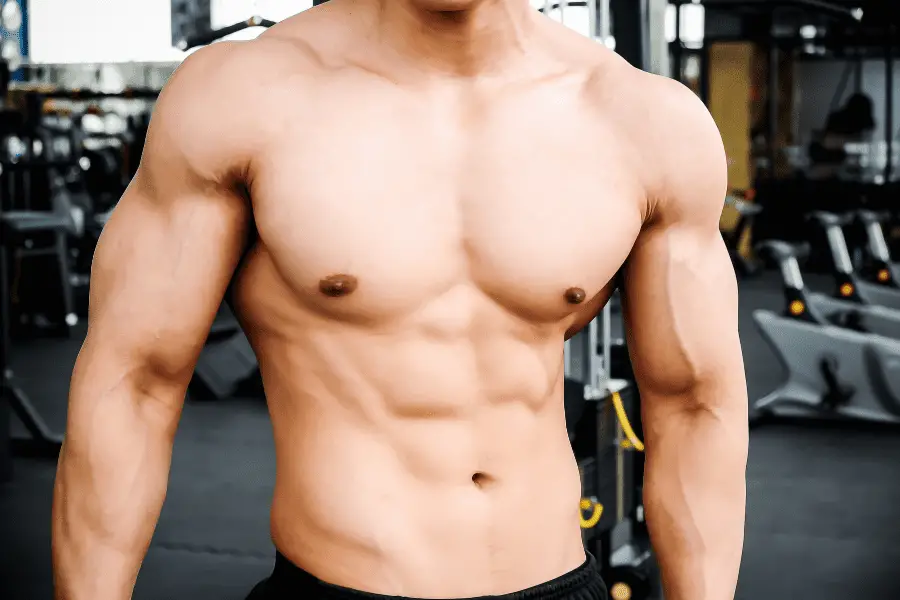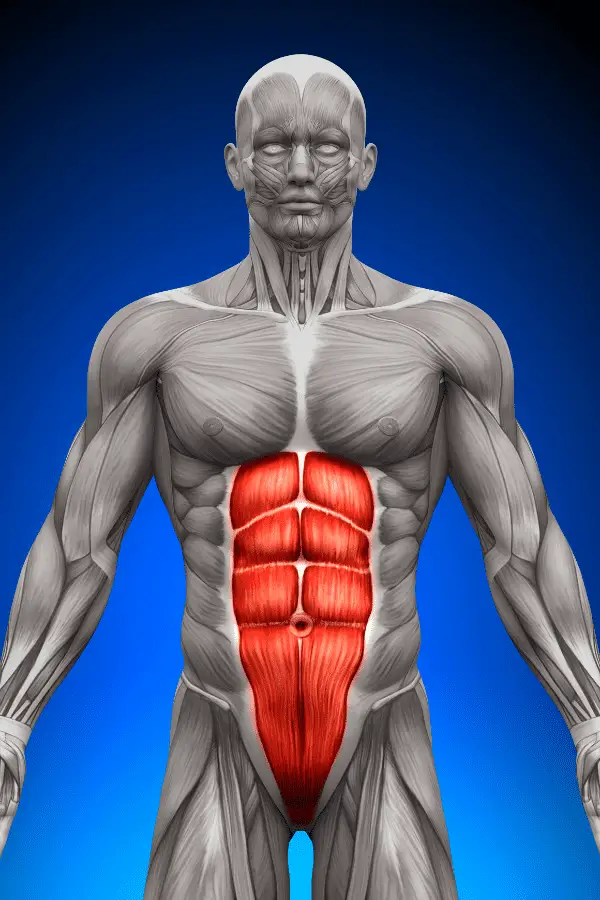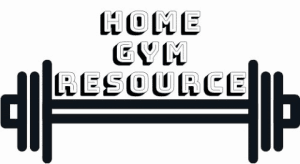It’s the holy grail of many gym-goers; the visible 6-pack abs. How much exercise a week do you have to do to actually get visible abs? Here’s what you need to know.
Doing ab exercises in isolation won’t result in visible abs if the body fat percentage is too high. 6-Pack abs are the result of both lowering body fat and growing the core muscles. 12-16 sets of direct ab work per week is good for beginners while advanced people can do up to 25 sets per week.
Let’s take a look at the details of those sets, which exercises you should count and how many repetitions per set works well as well as if exercise alone is enough to grow the abs.
Contents
What Is Necessary For Visible 6-Pack Abs?
The first thing to understand is that just doing ab exercises is not going to get you visible abs. It just doesn’t work that way, no matter how big your ab muscles are.
Your body fat percentage is a very important factor in if your abs are visible. It’s very simple, if there is too much fat on top of the abs, you don’t see them. For most men, you have to be at 15% body fat or below to have a visible 6-pack. Women can have a bit higher body fat but most women aren’t shooting for visible abs anyways. Everyone is different and stores/loses fat in different ways so 15% is not a law of nature but for most people that’s in the ballpark.

Your diet and cardio routine are going to be much more important in getting visible abs than doing sit-ups all day. That layer of fat on top of the abs must go or at least get a lot thinner if you want to see the abs.
Training the muscles in the core is the other part of the equation. You can have very low body fat but if the muscles aren’t developed, you still won’t see much. That’s where ab training comes in. You have to grow those abs to really make them pop out, how to do that properly, we’ll discuss below.
However, that doesn’t mean core training is useless for people that don’t want a 6-pack. The core is one of the most important muscle groups for strength, athletic performance, ease of daily life, longevity, and even your physique. Even if you don’t have visible abs, a strong core will improve how you look. And of course, if you’re on your way to a lower body fat percentage, it’s good to get the abs growing before you get low enough to see them so they’re easier to spot once you get there.
Also, the visible parts of the abs is mainly the Rectus Abdominus. That’s the muscle that creates the blocky look. That’s only one part of the core though. There are many more muscles in there that are very important for a strong core and the blocky abs alone are not necessarily the most important part except for looks. If you’re training abs anyways, you should focus on the other muscles like the Transfervus Abdominus and Obliques as well to create a balanced look and strength.
Suggested: Can you lose body fat on a stationary bike?
How Many Sets Per Week To Grow Abs?
So let’s say you’re on your way to a lower body fat percentage and want those abs to pop out so far you can see them through your T-shirt. What’s the best amount of volume to do this?
Too much of a good thing turns anything bad and working out is no different. You can go too far. While there are differences between people and how much they can handle, there are some general guidelines for the optimal amount of sets that will get you to the optimal amount for most people. In general, more sets will be better for muscle growth but at some point, you run into the limits of recovery. Once you can’t properly recover from a workout before the next one, you can’t train anymore or at least it’s not useful. But how much can most people train their abs before running into issues?
If you do any weightlifting with heavy weights and do compound exercises like the deadlift and squats, that’s enough to maintain muscle mass in the core, and for beginners, it’s probably even enough to gain a little muscle in the abs. It will however be very slow and while you might gain strength, the size gains will be limited.
To significantly grow your abs at least 4 sets of direct ab work per week and up to 25 sets per week, spread out over multiple workouts is best to grow your abs. You want to pick 2-3 exercises and spread the sets over those. 25 sets is a lot and for beginners, that amount of volume is not necessary. About 12-16 sets per week is great for beginners to grow their abs. Spread it out over at least 2 workouts but up to 5-6 times a week is not a problem either. Just don’t do less than 4 sets per workout.

Read more about ab training frequency and volume here
More than 25 sets per week is going to be a problem for many people because of recovery reasons. Workouts break down the muscle and this has to be repaired for the muscle to grow. If the muscle isn’t fully recovered before the next workout, you’re taking one step forward but two steps back. The abs are quite large muscles and take a lot of damage during heavy exercise so you have to keep an eye on if you recover quickly enough. If you don’t recover before the next workout, reduce the number of sets a little while keeping the weight and repetitions the same.
The sets mentioned above are ‘working’ sets. So warm-ups don’t count. Only sets that are done with the full resistance you can handle are working sets.
Also, the core is used for many other exercises. If you do those exercises before the core is fully recovered, you run the chance that the core isn’t back to full strength yet. On heavy compound exercises like deadlifts and squats, this can be dangerous. Since those exercises rely heavily on the core to stabilize the spine/upper body. If the strength is lacking, you might notice that you can’t lift those heavy weights with good form anymore. So if your main routine consists of heavy compound exercises, it’s a good idea to slowly dial in the core work to safely see where the limits are.
As said, these are general guidelines that work for most people. There are always genetic outliers that can handle much more or less. Also, this is for people that train without chemical ‘help’. If you do use performance enhancers this goes out the window since most of what those compounds do is make recovery faster. Also, keep in mind the other workouts you do have an impact on recovery.
In the end, it’s not a legal system, the amount of sets and type of exercise is just an indication of if your body is getting enough of a training impulse but not too much so you can’t recover. Counting the sets in this way is a way to keep track of the total training impulse you’re getting while avoiding overtraining.
What Is A Set?
Maybe it’s good to quickly think about what a set is. When you go to the gym or anywhere else you work out, you do exercises in short bursts of roughly 5-20 repetitions. One of those bursts is called a set. A set consists of a number of repetitions and you usually perform more than one set of one exercise. Three sets per exercise is very common but up to 5 sets per exercise is fine.
You do this because doing 100 repetitions in a row is not possible in most cases unless you use really light resistance and then it becomes less useful to begin with. Sets give you the time to recover a little and then you can put your muscles through more stress in total. The amount of sets in a workout has a big impact as you can see above but also the amount of repetitions in a set.
In general, the lower the amount of repetitions per set, the more the exercise focuses on strength, the more repetitions, the more focus on growth. However, that has to go together with the resistance. At the end of a set, you want to keep about 1-4 repetitions in reserve. That means for a set with higher repetitions, you use lighter weights (for you) and vice versa. Doing low repetitions with low weight isn’t going to do much and high repetitions with high weight will mean you fail prematurely.
For abs growth, doing high repetition sets from 15-30 repetitions is the best. Most people do sets in the 10-15 rep range and this is a good balance between building strength and size. However, if you exclusively want to focus on size, high-rep sets might work a little better.
Also, the core muscles need endurance for most tasks. So higher repetitions will train this as well. Using high resistance for the core is usually not easy to do anyways which is what you would need for lower repetitions.
What Is Direct Ab Training?
The amount of sets mentioned above is direct core work. That means exercises where the core is targeted hard and is the main mover. There are some exercises where the abs do a little of the work but aren’t the main muscle that’s targeted. Those sets don’t count as direct core work. The numbers above already take into account you do those other exercises anyways.
We all have an idea of what direct core exercises are. Most people will think about sit-ups, leg raises, and planks. Those are great exercises but not the only ones you can use. However, there are plenty of others. It’s a good idea to use a selection of different exercises to make sure your training targets all the different muscles your core has.
So direct ab training is doing exercises that directly target the abs and uses the core as the muscle group in isolation or as the main focus of the movement.
You don’t have to do a ton of different exercises every workout. You should do the same exercises a few weeks in a row. Doing them for 6-8 weeks in a row is fine. Improve as much as you can on those exercises and after those weeks, you should change them up so your abs get targeted in a slightly different way.
If you’re just looking for visible abs, it’s a good idea to put extra focus on the Rectus Abominus. What that muscle does is bring the chest and the hips closer to each other or resist movement the other way. So all the exercises that move the chest closer to the hips or the hips to the chest will work this muscle. Sit-ups, hanging leg raises, reverse crunches, and the likes do exactly that. However, that doesn’t mean you should forget about the rest of the core.

Best Ab Training Tools
While a balanced diet and a consistent workout routine are essential for achieving impressive ab results, using the right training tools can take your core workouts to the next level. There are some tools that are really effective to help you get a good ab workout.
You can find the best versions of these tools in this article.
Yoga Mat
A Yoga Mat might seem like a basic tool, but it’s an essential item for ab workouts. Core exercises often involve being horizontal, and a comfortable and supportive mat can make a significant difference in your training experience.
Here are some examples of exercises you can do with a Yoga mat.
Crunches: Lie on your back with your knees bent and feet flat on the mat. Perform crunches, lifting your shoulders off the mat while engaging your core. There are many different variations of crunches some of which are better than others.
Plank Variations: High planks, side planks, and forearm planks are just a few examples of very effective core exercises. engage your core and hold the position for a set time. These are more difficult than they initially look.
Why it’s effective: The Yoga Mat provides a cushioned and stable surface for core exercises, allowing you to focus on proper form and technique without discomfort. Additionally, it helps prevent pressure on the spine, making your ab workouts safer and more enjoyable.
Ab Wheel
The Ab Wheel, also known as the Ab Roller, is a deceptively simple yet highly effective tool for strengthening the abdominal muscles. It consists of a wheel with handles on both sides.
To use the Ab Wheel, begin on your knees with your hands gripping the handles and the wheel positioned in front of you. Engage your core, roll the wheel forward while maintaining a straight line from your shoulders to your knees, and then roll it back to the starting position.
Why it’s effective: The Ab Wheel challenges not only the rectus abdominis (the “six-pack” muscles) but also the deep stabilizing muscles of the core, including the transverse abdominis and obliques. Its rolling motion forces your core to work harder to stabilize your spine, making it a powerful tool for building core strength and stability.
This thing seems gimmicky but it actually works well.
Pull Up Bar
While the pull-up bar is primarily associated with upper-body workouts, it can be an excellent tool for targeting the core as well. Various hanging exercises engage the core muscles as they work to stabilize your body during movement.
Hanging leg raises: Hang from the bar with your arms fully extended and lift your legs up towards your chest, keeping them straight. This exercise targets the lower abs and hip flexors.
Windshield wipers: Hang from the bar and lift your legs towards one side, then lower them to the other side in a controlled, controlled motion. This movement targets the obliques and improves rotational core strength.
Why it’s effective: Hanging exercises force the core muscles to engage isometrically, which means they have to contract to maintain stability during movement. This helps develop core strength and improves overall athleticism.
Pull-up bars come in different forms. Some are attached to a power rack but there are simple and cheap standalone options that can be mounted in a doorway as well.
Kettlebell
Kettlebells are versatile and dynamic tools that can add intensity and challenge to your core workouts. They allow you to perform various movements that engage the core muscles, such as Russian twists, and Turkish get-ups but also to add weight to your crunches.
Russian Twists: Sit on the floor with your knees bent and feet flat. Hold the kettlebell with both hands and twist your torso to one side, then the other, engaging your obliques. Lifting your feet from the floor makes this even more difficult.
Weighted crunches: These are done like normal crunches but with extra weight in your hands to make them more challenging.
Why it’s effective: Kettlebell exercises require core stability and control to perform correctly. The dynamic nature of kettlebell movements also engages multiple muscle groups simultaneously, leading to a more efficient and effective core workout.
Optimizing Ab Growth After Workout
If you do the amount of sets and repetitions described above with the right resistance, is that enough to grow your abs? Most people will get good ab growth if you follow the prescriptions above.
However, working out is the signal for your body to grow a muscle if you do it right. Doing the sets above is the optimal amount of signaling for most people. That way, the signal strong enough without becoming detrimental. While that’s a necessary part to grow your muscles, it’s not the only factor in play. One of those factors is already built into the amount of work described above and that’s; recovery. If you do too much, you break down the muscles so much your body can’t recover quickly enough and you have to wait longer for the next workout which works out sub optimally in the end.
The 25 sets mentioned above are what most people can recover from for an extended period of time. Although beginners can likely handle a little less. That doesn’t mean you can influence that recovery to some degree though.

Your body does not just have a set amount of recovery it can do. While there are some genetic and hormonal factors that are difficult to control, there are some things you can alter to improve it. Better recovery means faster muscle growth.
Besides uncontrollable factors, recovery is also largely dependent on diet and sleep. The diet gives your body the fuel to grow muscle. Sleep is where most of the muscle repair actually happens.
Eat enough clean food that gives you a good amount of vitamins and other micronutrients. Eat about 200-300 more calories than you need on a given day. It’s difficult to build muscle in a calorie deficit. You can calculate your daily calorie needs although those calculators aren’t too accurate usually so it might take some precise tracking of calories, weight, and muscle mass to figure out if you’re in the right ballpark. This is the most difficult part of growing muscle.
However, if you have to lose weight to unveil your abs, things get quite complicated. You want to both gain muscle and lose fat at the same time. This is very difficult. If you are willing to just focus on the abs and sacrifice muscle growth in the rest of your body, you can lower the amount of calories to just (200-300 Kcal) under maintenance. Train the core with high repetitions and as the number of sets mentioned above. But reduce the amount of volume for other muscles. Just train the other muscles with lower repetitions and fewer sets but higher weight. That way you keep up your strength as much as possible. It’s hard to avoid all muscle and strength loss on a calorie deficit.
Besides enough calories, it’s a good idea to get enough protein. You don’t need to drink protein shakes the whole day although shakes can be good to supplement your diet sometimes. Most research papers seem to suggest that there is no benefit in consuming more than 0.8 grams of protein per lbs. of body weight and a bit less than that is perfectly fine for the majority of people. So if you weigh 100 lbs., consuming 70-80 grams of protein per day is plenty.
Sleep is very important to recovery and you should aim to get about 8 hours a night. Some high-level athletes sleep a few hours more than that just because their body needs more recovery time. And if you don’t have time to sleep more, improving sleep quality will make a massive difference as well. Not only for muscle building but for your quality of life in general.
